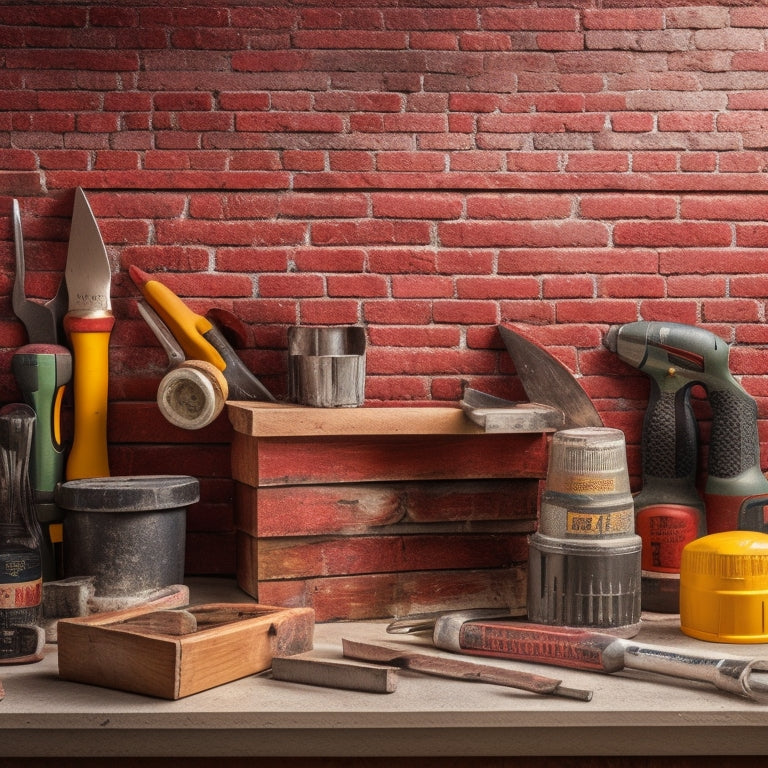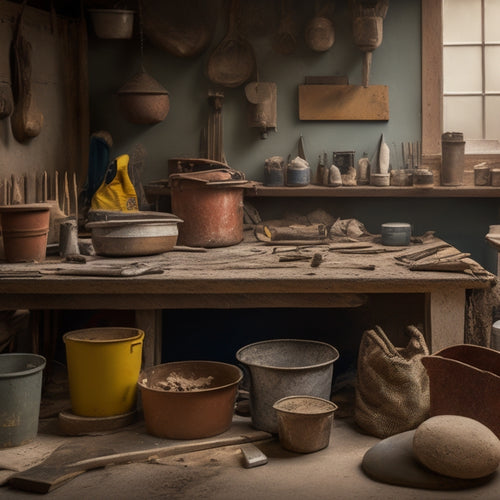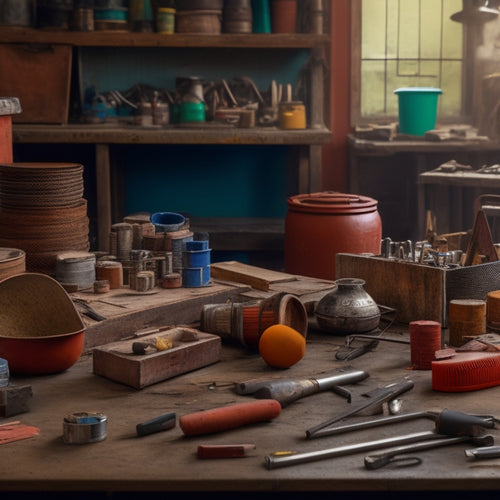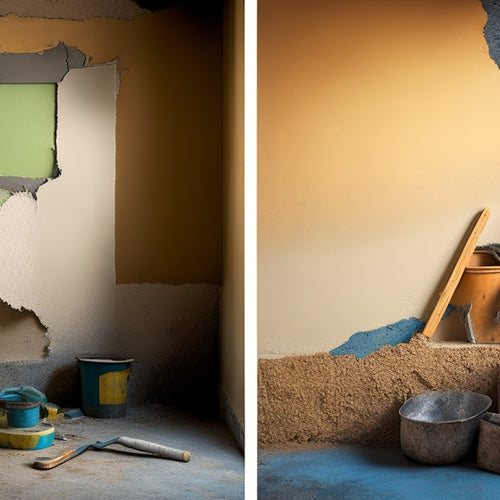
Budgeting for Exterior Wall Renovation Tools
Share
You'll need to budget between $200 to $500 for specialized block stucco renovation tools, including a stucco saw, mixing paddle, and application trowel, to achieve a professional finish. Additionally, you'll need to take into account power tool expenses, such as drills and circular saws, which can range from $100 to $500. Rental fees for equipment like scaffolding can add up quickly, making it crucial to calculate costs based on duration and compare options. As you plan your exterior wall renovation, remember to also factor in labor costs, material expenses, and safety gear fees to guarantee an all-encompassing budget that covers all aspects of the project.
Key Takeaways
• Block stucco renovation tools, such as stucco saws and mixing paddles, cost between $200 and $500 depending on quality and brand.
• High-quality power tools, including drills and circular saws, are necessary for a professional finish and cost between $100 and $500.
• Equipment rental fees vary depending on duration, with daily, weekly, and monthly rates available, and may include additional delivery or pickup charges.
• Budgeting for tool maintenance, including blade and bit replacements, is crucial to ensure the longevity of tools and equipment.
• Investing in high-quality tools and equipment can reduce labor costs and improve the overall efficiency of the renovation project.
Block Stucco Renovation Tool Costs
When tackling a block stucco renovation, you'll need to account for the costs of specialized tools, including a stucco saw, mixing paddle, and application trowel, which can range from $200 to $500, depending on the quality and brand.
Don't be caught off guard by these expenses, as they're vital for achieving a professional finish. You'll also need to take into account the costs of stucco mix, wire mesh, and other materials necessary for the job.
Mastering stucco application techniques is key to a successful renovation. You'll want to invest in high-quality tools that will make the process smoother and more efficient.
Additionally, regular block wall maintenance is essential to prevent water damage and structural issues. By factoring in these costs upfront, you'll avoid costly surprises down the line.
Calculating Equipment Rental Fees
When calculating equipment rental fees, you'll need to contemplate the rental period costs, including daily, weekly, or monthly rates.
You'll also need to evaluate the equipment rental options available, such as renting from a local supplier or opting for a national chain.
Rental Period Costs
Your equipment rental fees are calculated based on the duration you need the tools, with rates varying depending on the type of equipment and rental duration. The rental duration impact is significant, as longer rental periods typically result in higher costs.
When making a tool rental comparison, consider the daily, weekly, or monthly rates for each piece of equipment.
For instance, a scaffolding rental might cost $50 per day, $150 per week, or $300 per month. If you need it for a 10-day project, the daily rate would be the most cost-effective option. However, if your project spans several weeks, the weekly or monthly rate might be a better choice.
Be sure to factor in any additional fees, such as delivery or pickup charges, to get an accurate estimate of your total rental costs. By understanding the rental period costs, you can make informed decisions and stay within your budget.
Equipment Rental Options
You have three primary equipment rental options to evaluate when calculating equipment rental fees: renting from a local vendor, renting from a national chain, or purchasing equipment outright. Each option has its pros and cons, so let's break it down.
Renting from a local vendor can provide more personalized service and flexible rental periods, but may have limited equipment options. National chains, on the other hand, often have a wider range of equipment and standardized pricing, but may have less flexible rental periods. Purchasing equipment outright eliminates rental fees, but requires a significant upfront investment and ongoing tool maintenance tips to keep your gear in top shape.
When evaluating rental company options, consider factors like equipment availability, rental period flexibility, and maintenance support. Some rental companies may offer additional services, like equipment delivery or on-site training, which can impact your overall costs.
Be sure to calculate these extras into your budget to avoid any surprises. By weighing your options carefully, you can choose the best equipment rental strategy for your exterior wall renovation project and stay on budget.
Labor Costs for Demolition Work
When you're budgeting for labor costs in demolition work, you'll need to take into account the methods you'll use to remove debris, as this will impact your expenses.
You'll also need to factor in the cost of obtaining necessary permits, which can vary depending on your location and the scope of your project.
Additionally, you'll want to reflect on the site preparation needs that will be required to guarantee a safe and efficient demolition process.
Debris Removal Methods
As you commence on your exterior wall renovation, you're probably wondering how to tackle the not-so-glamorous task of debris removal.
How do demolition contractors typically approach debris removal, and what labor costs can homeowners expect to incur for this phase of the renovation project?
Demolition contractors usually develop a debris disposal plan, which involves identifying the types and quantities of waste generated during demolition. They'll then decide on the most efficient cleanup strategies, such as separating recyclable materials from non-recyclable ones.
This strategic approach helps minimize waste disposal costs and reduces the project's environmental footprint.
As a homeowner, you can expect to pay between $2 and $5 per square foot of demolition area for debris removal labor costs. This may seem like a significant expense, but it's a necessary evil to guarantee a safe and clean worksite.
Demolition Permit Costs
Demolition permits, which are mandatory for most renovation projects, add a significant layer of complexity and cost to the demolition process. Labor costs for permit acquisition and compliance can range from $500 to $2,000, depending on your location and the scope of the project.
You'll need to factor these costs into your budget, as they can't be avoided.
Demolition regulations vary by region, so it's crucial to familiarize yourself with local ordinances and codes. You'll need to submit a permit application, which typically includes detailed plans and drawings of your project.
This is where things can get hairy, as you'll need to verify your application is accurate and complete to avoid delays or rejections.
Site Preparation Needs
You'll need to budget for labor costs associated with site preparation, which can range from $3,000 to $10,000 or more, depending on the extent of demolition required and the complexity of the site.
Don't underestimate the significance of a thorough site assessment before you start swinging that wrecking ball. You'll need to identify potential hazards, like asbestos or lead paint, and factor in the cost of safely removing them.
Ground preparation is also essential - you'll need to clear the area of debris, vegetation, and any existing structures that might get in the way of your renovation.
Think of it like preparing a canvas for a masterpiece - you need a clean slate before you can create something beautiful.
And, let's be real, you don't want to be stuck with a half-demolished site because you didn't budget for the necessary labor costs.
So, take the time to get it right, and your exterior wall renovation will be off to a solid start.
Material Expenses for Stucco Repair
Stucco repair materials, including cement, sand, and lime, will account for a significant portion of your renovation budget. You'll need to calculate the quantity of each material required, depending on the type of stucco you're working with.
There are three main stucco types: traditional, synthetic, and insulated. Each requires different repair techniques and materials. For instance, traditional stucco repairs often involve applying a new layer of stucco over the existing one, while synthetic stucco might need specialized adhesives.
To estimate material expenses, measure the area to be repaired and calculate the volume of materials needed. A general rule of thumb is to add 10-15% to your calculations to account for waste and unexpected repairs.
Don't forget to factor in the cost of any necessary additives, such as fibers or bonding agents. Keep in mind that using high-quality materials can save you money in the long run by reducing the likelihood of future repairs.
Scaffolding and Safety Gear Fees
Renting or purchasing scaffolding and safety gear is an essential investment for your renovation project, as it enables you to access high areas and protects you from falls and other hazards.
You'll need to decide between different scaffolding types, such as frame, tube, and clamp, or mast climbing scaffolds, depending on the complexity of your project.
Don't forget to factor in the cost of safety gear, like harnesses, lanyards, and guardrails, to guarantee you're compliant with safety regulations.
According to OSHA, scaffolding must be inspected daily, and you'll need to provide proper training for your team on its use.
You can expect to pay between $500 to $2,000 per week for scaffolding rental, depending on the size and type.
Safety gear prices vary, but budget at least $500 for a basic setup.
Remember, safety should always come first, so don't skimp on these essential expenses.
With the right scaffolding and safety gear, you'll be able to tackle your exterior wall renovation with confidence and peace of mind.
Power Tool Expenses and Upgrades
With your scaffolding and safety gear in place, it's time to turn your attention to the power tools that will drive your exterior wall renovation forward.
Calculating the expenses for these tools is an essential part of your overall budget. You'll need to take into account the cost of purchasing or renting the necessary power tools, as well as maintenance and potential upgrades.
Here are three key power tool expenses to factor into your budget:
-
Drill and bits: A high-quality drill is vital for exterior wall renovation. Expect to pay around $100-$300 for a decent drill, and an additional $50-$100 for a set of durable bits.
-
Impact wrench: If you're working with heavy materials or stubborn fasteners, an impact wrench is a must-have. Prices range from $100-$500, depending on the brand and features.
-
Circular saw: A circular saw is perfect for cutting lumber and other materials. You can find a reliable saw from a reputable power tool brand like DeWalt or Makita for $100-$300.
Remember to also budget for tool maintenance, such as replacing worn-out blades and bits.
Miscellaneous Renovation Expenses
Beyond power tool expenses, you'll need to account for several miscellaneous costs that can add up quickly, including dumpsters, tarps, and other site preparation expenses.
Think of these as the 'Miscellaneous Mayhem' category – you know, all the little things that'll drive you crazy if you don't plan for them.
Don't underestimate the cost of keeping your site clean and organized; it's not just about aesthetics, it's about safety and efficiency.
Frequently Asked Questions
Can I Reuse Old Stucco Materials to Reduce Renovation Costs?
You're wondering if you can reuse old stucco materials to save some cash?
Well, let's get real - stucco durability is key here. If the old stuff is still in decent shape, you might be able to repurpose it, but don't risk compromising the structural integrity of your wall.
Material sourcing can be a challenge, but it's better to invest in new stucco than to deal with costly repairs down the line.
How Do I Ensure Accurate Estimates for Equipment Rental Fees?
Imagine you're renovating a 5-story building and need aerial lifts to access those hard-to-reach areas.
To avoid cost surprises, you'll want to accurately estimate equipment rental fees. When requesting quotes, specify the exact model and duration needed.
Get quotes from multiple vendors and ask about any additional fees, like delivery or fuel charges.
Are There Any Eco-Friendly Stucco Materials Available for Renovation?
You're on a mission to go green with your exterior wall renovation!
You're in luck - there are sustainable stucco options available that won't break the bank or the planet. Look for eco-friendly finishes made from natural materials like lime, clay, or earth oxides.
These alternatives to traditional stucco reduce carbon footprint and offer similar durability. Plus, they're often more breathable, reducing moisture issues.
You'll be the envy of the neighborhood with your eco-chic exterior!
What Are the Most Common Stucco Renovation Mistakes to Avoid?
You're about to plunge into stucco renovation, and you're smart to avoid common mistakes.
The theory is that a smooth, even application is key, but in reality, it's easy to mess up.
You'll want to master stucco application techniques to prevent uneven finishes, cracks, and water damage.
Don't fall into common repair pitfalls like inadequate surface prep, insufficient drainage, or rushed curing times.
Can I DIY Stucco Renovation or Do I Need Professional Help?
You're wondering if you can DIY stucco renovation or if it's better to call in the pros.
Let's get real, DIY stucco techniques can be tricky, and without proper experience, you might end up with more problems than you started with.
Don't risk it! Seek professional stucco advice to guarantee a flawless finish.
Trust us, your wallet (and your walls) will thank you in the long run.
Conclusion
As you wrap up your exterior wall renovation, remember that the devil's in the details.
It's the little expenses that can add up to a big surprise.
Don't let your project's financial foundation crumble under the weight of unexpected costs.
By accounting for every tool, rental, and material, you'll be building on solid ground.
So, take a deep breath, crunch the numbers, and watch your renovation rise from the ashes, strong and beautiful, like a phoenix from the dust.
Related Posts
-

What Plastering Tools Do You Need for Renovation
You'll need a range of specialized tools to tackle a plastering renovation project efficiently and effectively. Essen...
-

Budget-Friendly Materials for Your Home Renovation Needs
As you initiate your home renovation, you're enthusiastic to find budget-friendly materials that fit your vision with...
-

Top 3 Tools to Buy for Stucco Renovation
You'll need the right tools to guarantee a successful stucco renovation, and it all starts with three essential items...


